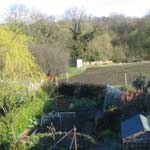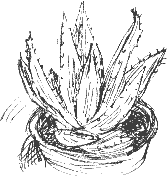
In this view from my studio window, what are those parallel
lines in the meadow that show up in the afternoon light? They were there
when we moved here twenty years ago.
Old boundaries? An old drainage system? Some relic of activity
associated with the disused sandstone quarry hidden amongst the trees
to the left?
None of these seems likely to me but I don't have a better
explanation.
The larger house, right of centre on the skyline, is Netherton
Hall. The present building is 18th century but there has been
a hall at Netherton since the days of Henry VIII at least.
Down to Earth
I've cropped the panorama, taken this afternoon, to exclude
all traces of back gardens and next door's extension. Only the large green
'caterpillar' at the bottom hints at the neatly trimmed evergreens next
door, in contrast to the bare oaks and ashes and the greening willows
alongside Coxley Beck. The stream follows a geological fault which brings
beds of sandstone (on the far side of the beck) alongside the softer rocks
(shale or mudstone) that underlie the meadow.
 Our
back garden (left) benefits from its meadow soil. When the house
was built in the 1930s the long back garden was enclosed directly from
the meadow. These days the first stage in developing a site for housing
is often clearing the topsoil, usually as a prelude to raising site levels
or flattening out natural contours. Our
back garden (left) benefits from its meadow soil. When the house
was built in the 1930s the long back garden was enclosed directly from
the meadow. These days the first stage in developing a site for housing
is often clearing the topsoil, usually as a prelude to raising site levels
or flattening out natural contours.
 Succulent Succulent
It's after sunset before I have chance to stop and draw.
This succulent with prickly-edged leaves which we keep on the kitchen
windowsill provides a subject but its a subject I would rather have drawn
in natural light: the 'leaves' (I guess they are in fact modified stems)
are canoe-shaped but it's difficult to bring this out when drawing by
artificial light from several sources. 
Richard Bell, richard@willowisland.co.uk
|